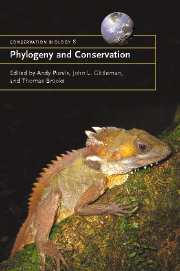Book contents
- Frontmatter
- Contents
- List of contributors
- 1 Phylogeny and conservation
- Part 1 Units and currencies
- Part 2 Inferring evolutionary processes
- 7 Age and area revisited: identifying global patterns and implications for conservation
- 8 Putting process on the map: why ecotones are important for preserving biodiversity
- 9 The oldest rainforests in Africa: stability or resilience for survival and diversity?
- 10 Late Tertiary and Quaternary climate change and centres of endemism in the southern African flora
- 11 Historical biogeography, diversity and conservation of Australia's tropical rainforest herpetofauna
- Part 3 Effects of human processes
- Part 4 Prognosis
- Index
- References
9 - The oldest rainforests in Africa: stability or resilience for survival and diversity?
Published online by Cambridge University Press: 04 December 2009
- Frontmatter
- Contents
- List of contributors
- 1 Phylogeny and conservation
- Part 1 Units and currencies
- Part 2 Inferring evolutionary processes
- 7 Age and area revisited: identifying global patterns and implications for conservation
- 8 Putting process on the map: why ecotones are important for preserving biodiversity
- 9 The oldest rainforests in Africa: stability or resilience for survival and diversity?
- 10 Late Tertiary and Quaternary climate change and centres of endemism in the southern African flora
- 11 Historical biogeography, diversity and conservation of Australia's tropical rainforest herpetofauna
- Part 3 Effects of human processes
- Part 4 Prognosis
- Index
- References
Summary
INTRODUCTION
Conservation priorities are often determined by superlatives. For example, they might be set by the presence of the biggest tree, the most species-rich place, or the oldest rainforest. But as well as having a ‘book of records’ approach to conservation, we should also be thinking about what these measures tell us about the ecology and phylogenetic history of the species we wish to conserve. This information can then help guide the design of effective conservation practices. We might ask whether the oldest rainforests, as determined by the presence of phylogenetic relicts, are there because they were in places that did not suffer change, in other words they were stable over ecological and evolutionary time, or whether they are there because the ecosystem is particularly resilient to change. The resilience could arise from several different reasons. The species themselves could be particularly tolerant of change, or the ecosystem as a whole could be resilient to change, or the place where the old rainforest occurs could be topographically diverse and its constituent species able to move locally when change occurs. The distinction is extremely important for conservation management. An old rainforest adapted to stability will not survive the types of change resulting from human interference, whereas one composed of ecologically tolerant species will. For rainforests there are two key reasons for thinking in terms of dynamic ecological and evolutionary processes rather than a static preservation approach.
- Type
- Chapter
- Information
- Phylogeny and Conservation , pp. 198 - 229Publisher: Cambridge University PressPrint publication year: 2005
References
- 19
- Cited by



